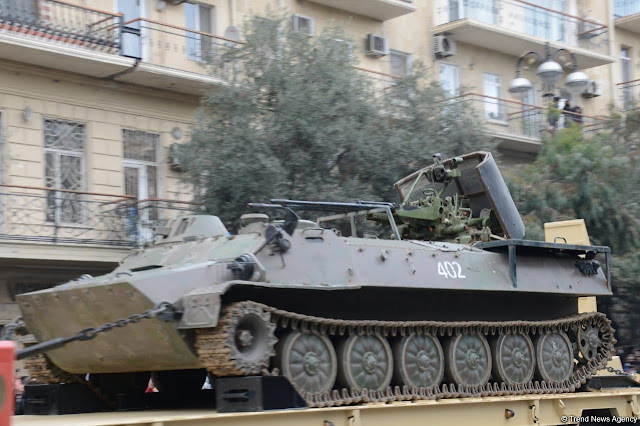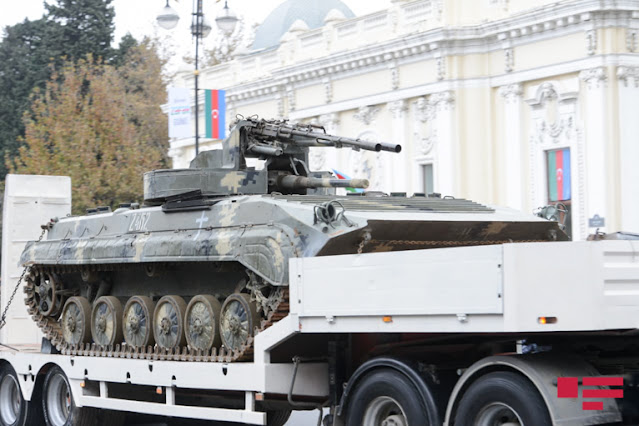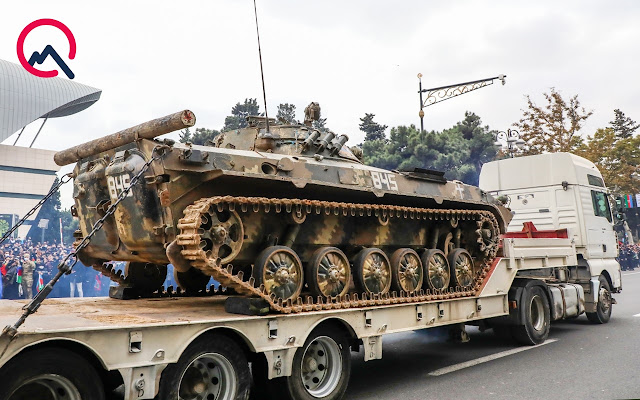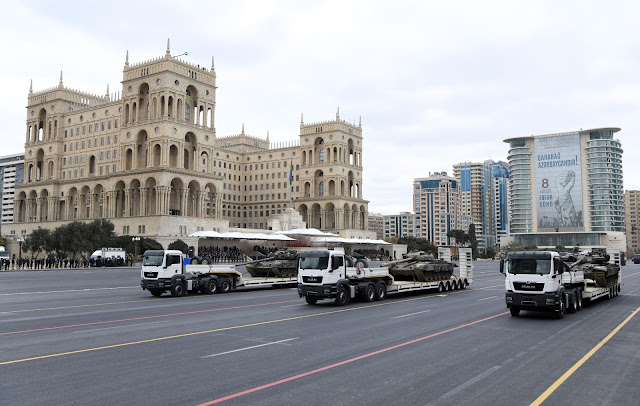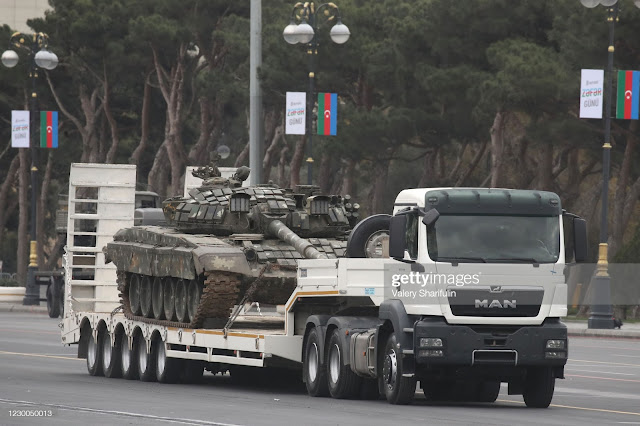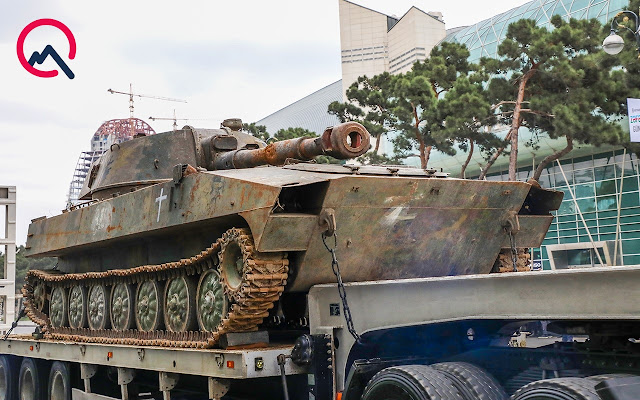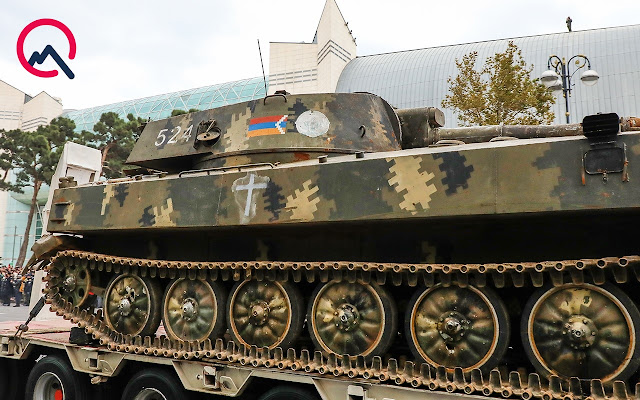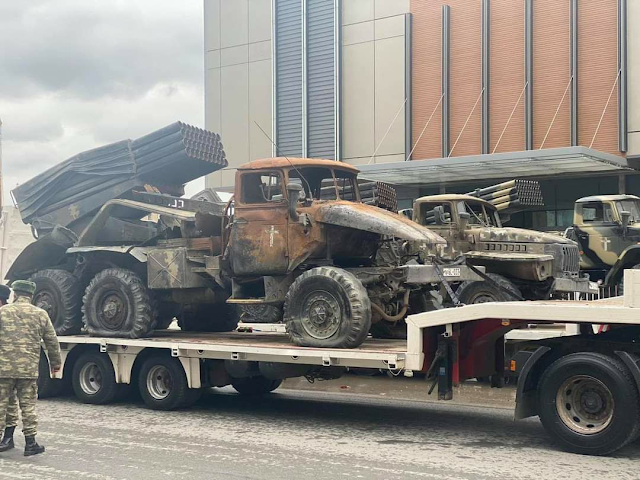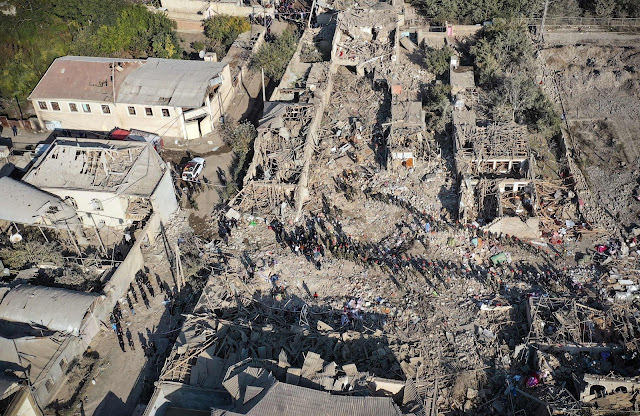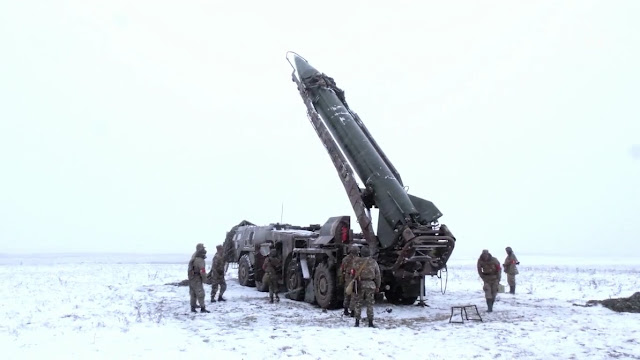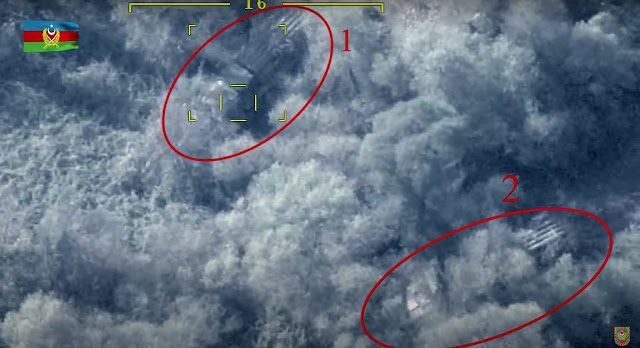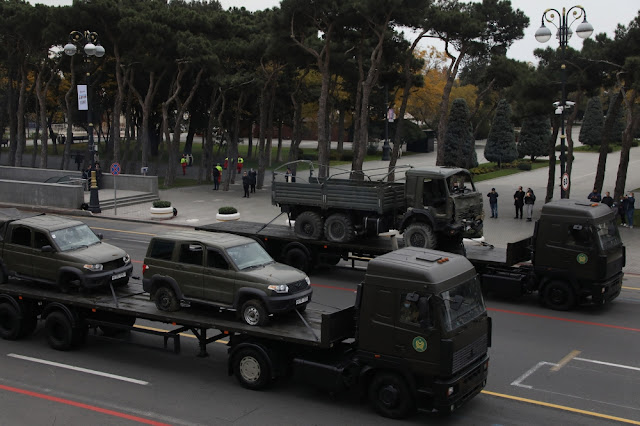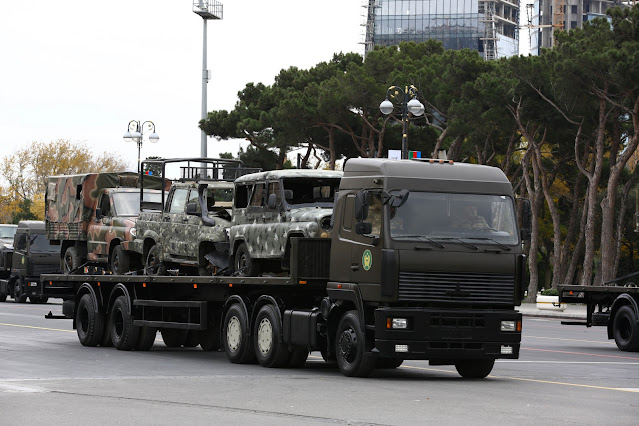Ghost soldier
Хижак
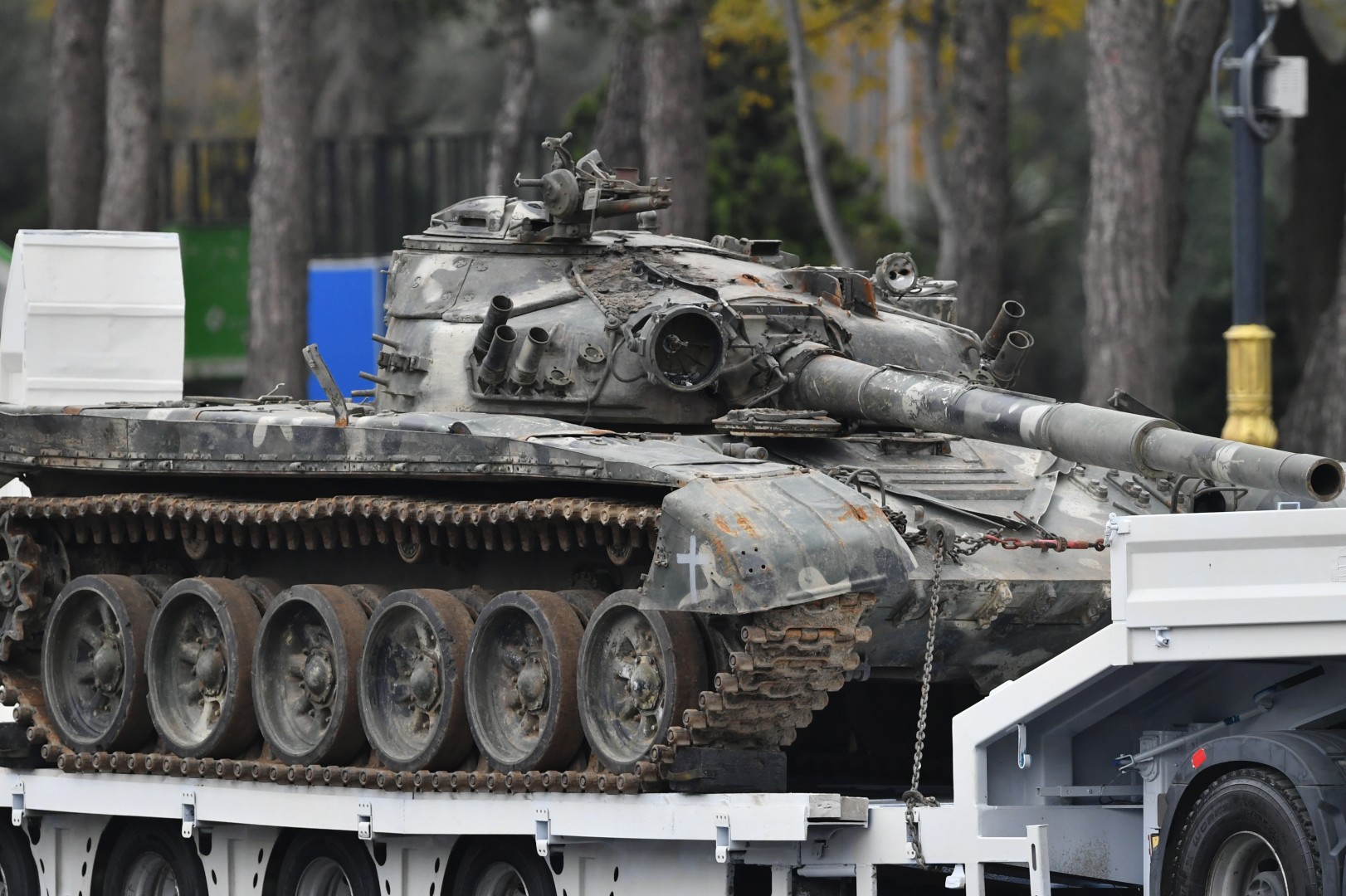
If Azerbaijan starts a war, Armenian tanks will go as far as Baku. (Artsrun Hovhannisyan, Press Secretary of the Ministry of Defence of Armenia, September 2020)
In a way surely different from what the Ministry of Defence of Armenia had envisaged, Armenian military equipment was on full display during Azerbaijan's Victory Parade on the 10th of December 2020. Marching through Baku's Freedom Square, the parade offered a glimpse of some of the equipment used by both sides during the 44-day long Nagorno-Karabakh war.
While the parade segment with military trophies was sizeable, with row upon row fielding yet another type of weapon system ultimately overcome by drone warfare, the Armenian equipment on display was roughly one-tenth of the total amount of weaponry and vehicles captured by Azerbaijan. [1] In fact, even if we assume double the amount of losses confirmed to have been suffered by Azerbaijan, its military would still have captured more military equipment than it lost during the war.
Contrary to popular belief however, the massive losses in equipment suffered by Armenia are actually less significant than one might think. With a quantity of equipment better suited for a regional power than an economically struggling nation with a relatively tiny population, its composition of forces had always been highly geared towards the defence of Nagorno-Karabakh and the Armenian-occupied territories surrounding this region. Having relented control over nearly half of Nagorno-Karabakh and all of the surrounding territories, the reason for a large standing army is now lost along with it.
The rows of battered Soviet equipment, most of which dating from the 1970s and 1980s, offered a stark contrast to the modern city of Baku, which has rapidly developed in the past years to become the metropolis it is today. The paraded Armenian equipment also stood in contrast to the masses of weapons systems displayed by Azerbaijan during the parade, many of which have been recently acquired and belong to the most modern systems in their respective classes.
The parade can be watched in its entirety here. The segment with Armenian military equipment starts from 1:02:40.
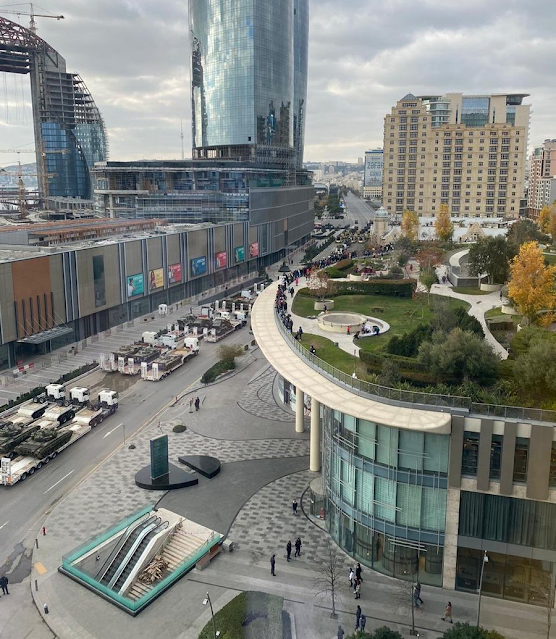
The first entry to the parade was a highly symbolic one for both nations: A composition made from the license plates of Armenian military trucks and jeeps captured by Azerbaijan during the conflict. This was a clear nod to Armenia's 'number plate wall', which it constructed from the license plates of cars previously owned by Azerbaijani citizens Armenia had just expelled from Nagorno-Karabakh and the seven surrounding regions in the 1990s. On the Azerbaijani wall, 'Qarabağ Azerbaycandir!' - "Karabakh is Azerbaijan!" was reiterated.

Heading off the vehicle section of the parade were three KAMAZ trucks with (Christian) crosses painted on them. Although sometimes applied to military vehicles by their Armenian crews, the crosses featured on vehicles in the parade were in fact applied by Azerbaijan to mark the difference between captured Armenian equipment and Azerbaijani equipment.
Throughout the duration of the conflict, Armenia continued to receive several batches of KAMAZ trucks from Russia through Iran. [1] These were not wartime military aid from Russia to support Armenia in its battles against Azerbaijan, but rather part of a large order placed before the outbreak of the war. Opposed to arms embargos imposed against any nation as a rule, Russia clearly honored its contractual obligations in spite of the war.
Of interest are the various types of mortars transported on the back of each truck, which include (from left to right) 60mm M57s, 82mm M69s, 120mm M74s, all of Yugoslavian origin, and a type of hell cannon. The latter was a surprise finding on the battlefields of Nagorno-Karabakh, as hell cannons are normally associated with rebel groups that lack access to more conventional weaponry.
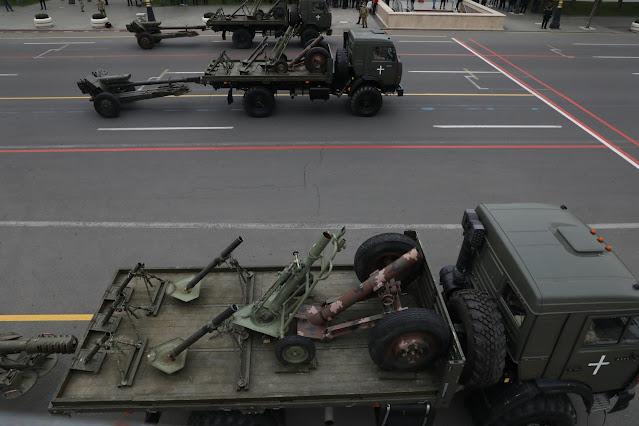
Capable of laying down fire over far greater ranges than mortars are the many towed artillery pieces in Armenian service, of which the 122mm D-30 howitzer (pictured) is the most numerous. Heavier systems include the 152mm D-20 howitzer and the 2A36 Giatsint-B field-gun of the same calibre, and even WWII-era 122 mm M-30 and 152mm D-1 gun-howitzers and anti-aircraft guns converted to the role of artillery (KS-19) were still in frontline use in 2020.
Considerably cheaper than their mobile counterparts on tracks, many nations have begun to address the limited mobility of towed artillery by installing them on trucks. Surprisingly, this development was never initiated in Armenia, and almost all towed artillery pieces were placed in pre-prepared pits, which although giving some protection against counter-artillery fire, left them completely exposed to drones hovering overhead. It should thus come as no surprise that no less than 120 artillery pieces were destroyed by Bayraktar TB2 UAVs alone (out of more than 200 artillery pieces confirmed to have been lost by Armenia in total). [2] Often picked off one by one, the wartime life of an Armenian artilleryman must have been a truly terrifying experience, bringing with it a short life expectancy.
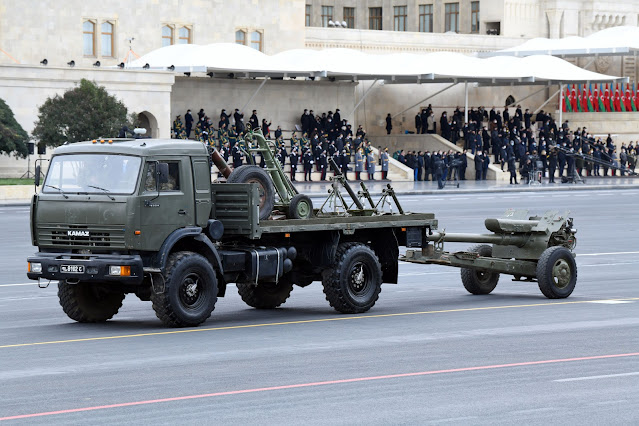
Further to the rear, three Ural-4320 trucks appeared carrying 152mm D-20 gun-howitzers and a selection of anti-tank guided missiles (ATGMs), recoilless rifles and heavy machine guns on their flatbed. These included six examples of the dreaded 9M133 Kornet, responsible for wrecking havoc among armoured fighting vehicles, structures and clusters of soldiers on key battlegrounds in Syria. In the Nagorno-Karabakh war, ATGMs played only a small role as the Armenian ATGM teams usually got neutralised or were forced to retreat by drones, artillery and missile fire before the tanks they were supposed to hit ever got in sight.
Nevertheless, in what was likely meant as a morale boost by the Armenian MoD, footage of reservists undergoing training on the 9K115 Metis ATGM systems was regularly aired on national TV. Originally designed by the Soviet Union to provide its soldiers with a lighter ATGM system compared to the 9M113 Konkurs, the lack of range and penetration capabilities of its 9M131 missile meant it proved less popular than originally envisioned. Of course, with a range of just one kilometre (compared to more than five kilometres for the 9M133 Kornet), their impact on the seemingly unstoppable advance of the Azerbaijan Army would have been negligible even in large numbers. Unsurprisingly, no footage of the missile system fired in anger during the war exists.
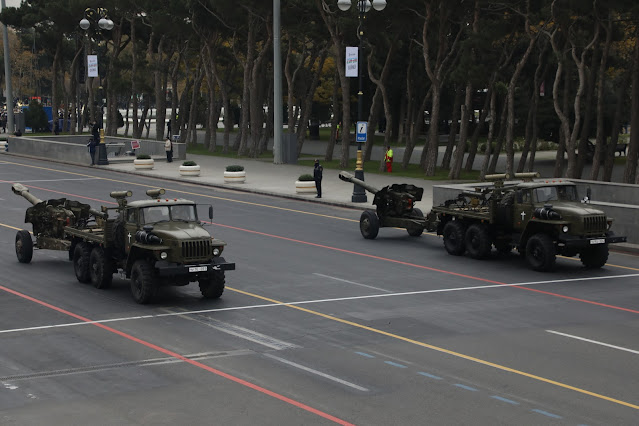
The next section of the parade was dedicated to the various types of anti-aircraft equipment employed during the conflict. First off, the ZSU-23-4 self-propelled anti-aircraft gun (SPAAG), a proven system that still has the potential of inflicting low-flying aircraft the knockout blow with its four 23mm cannons, together offering combined rate of fire of roughly 4,000 rounds per minute. Of course, a requirement is that such an aircraft should come within the ZSU-23-4's firing range, which due to the plethora of standoff weaponry deployed by any respectable air force nowadays is a rare occurrence. This is also true for drones, which can track and target systems like the ZSU-23-4 while flying too high and far away for the system to ever fend for itself.
The chances of targeting loitering munitions like the Harop are significantly better, as these must descend to earth during their attack run towards the target, thus entering the ZSU-23-4's firing range. Several nations have set out to improve the capabilities of their ZSU-23-4s to target such systems through the addition of more modern radars, electro-optical targeting equipment and even MANPADS. No such upgrade was performed by Armenia, and the ZSU-23-4's deficiencies in a modern war were once again made painfully clear. To ease parade training and avoid any possible damage to Freedom Square, tracked vehicles like the ZSU-23 were paraded on trailers rather than driving on stage on their own power.
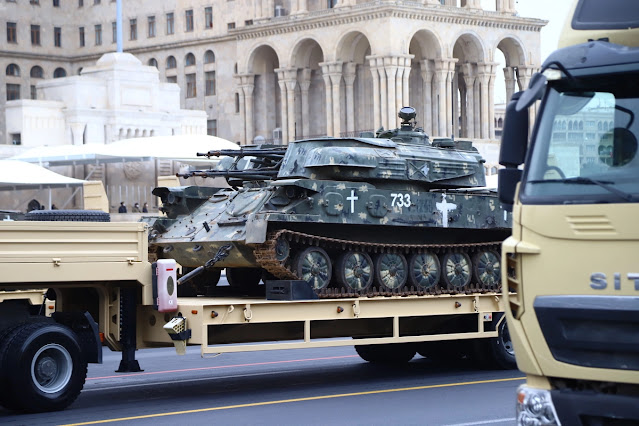
The 9K33 Osa (NATO designation: SA-8) still is Armenia's primary surface-to-air missile (SAM) system, and the country has made continued investments in keeping the system relevant to the 21st century. As recently as January 2020, Armenia showed off some of the 35 9K33 Osa-AK systems it had just purchased from Jordan for 27 million dollars. [3] [4] Although of an older variant than the Osa-AKM (and thus bringing with it decreased capabilities and a more limited range for its missiles) also in Armenian service, these systems were to be indigenously upgraded, which was made possible thanks to their extremely low purchase price.
While the acquisition and reliance on systems like the 9K33 was heavily critised both during and after the war, they were used with some success against loitering munitions during earlier clashes with Azerbaijan. Unfortunately for Armenia, all of the upgrades (consisting of new computers and optical systems) performed or planned on its 9K33 Osas failed to address one major issue: UAVs like the Bayraktar TB2 can target the 9K33 without ever needing to come into their range. Other countries sought to specifically address this issue, the most popular upgrade hence becoming known as the Osa-1T by Belarus (which was also acquired by Azerbaijan). But as modernising and upgrading each missile is amongst the most expensive features of such an upgrade, Armenia looked at other ways of increasing the efficiency of the 9K33s.
That said, during the war Bayraktar TB2s frequently operated within range of several 9K33 Osa systems at the same time without ever being targeted. It is likely that Armenia had envisaged that it could at least partially compensate the lack of capabilities of the 9K33 by deploying them in far greater numbers so that their engagement envelopes would overlap. This would mean that if a TB2 was in the process of engaging one 9K33 it would automatically fly into the range of another system located nearby. As Armenia found out the hard way, these systems turned out to be completely unable to identify the Bayraktar TB2s flying circles above them even with their radar system visibly turned on. This was likely the result of the TB2's low radar visibility, and also possibly due to the use of electronic warfare (EW) measures by Azerbaijan, resulting in at least 14 9K33 Osas destroyed with no TB2s lost in return. [2]
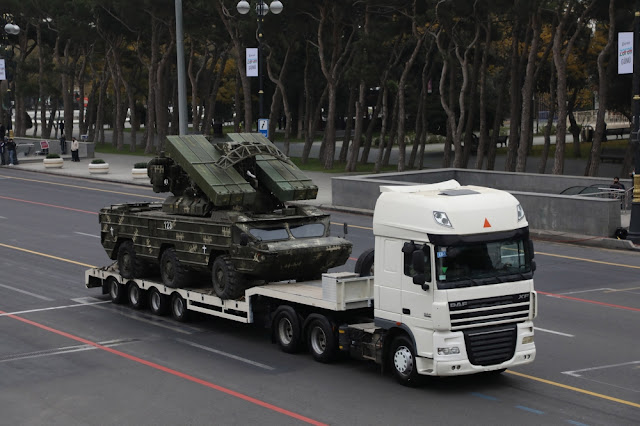
Longer-range systems like the 2K12 Kub (SA-6) fared no better, and like the 2K11 Krug (SA-4) also still in active service in Armenia, essentially played no role during the war. Nonetheless, Armenia still maintained at least two sites of these aging systems, although only the one near the city of Shusha appears to have been active during the outbreak of hostilities. Interestingly, no attempt was made to reactivate the other site during the war, which didn't stop Azerbaijan from striking the 1S91 radar (another captured example of which is pictured below) and empty launchers as a precautionary measure.
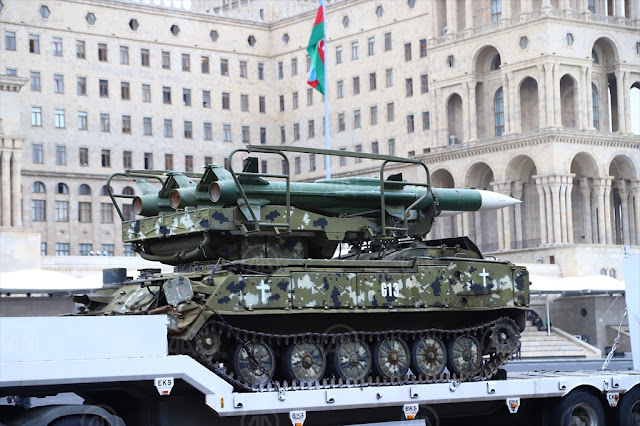
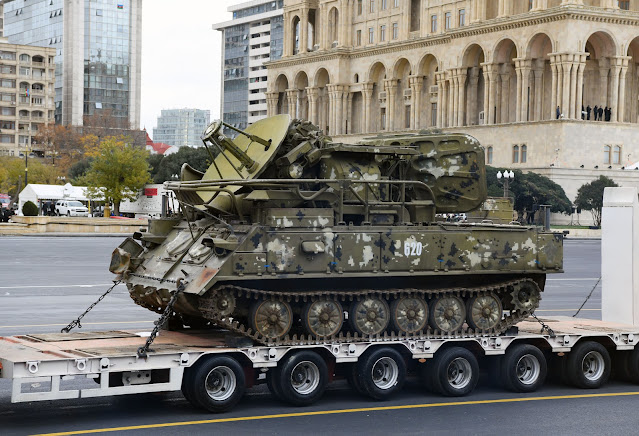
In defence of the 2K12, neither its replacement system the Buk-M1-2 nor the Tor-M2KM or even the vaunted S-300 had any impact on aerial warfare occurring above Nagorno-Karabakh. For the Tor-M2KM, perhaps its sole merit is that only one system is (confirmed) to have been tracked by a Bayraktar TB2 before being destroyed by two loitering munitions and a missile strike subsequently dispatched to its position. [5] Although it was envisaged that the Tor-M2KM could operate as a hunter-killer system in Nagorno-Karbakh, using its small footprint, ease of camouflage and mobility to escape from the attention of enemy UAVs, the Tor along with all other systems clearly became the hunted party instead.
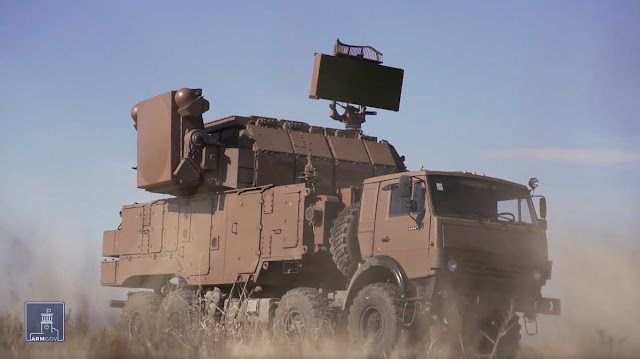
While the standard Russian response is often to blame the operators of the SAM system or to claim that the system in question was never meant to target the munition or drone that dealt it the finishing blow, every layer of Armenia's air defence umbrella in Armenia was soundly defeated at the hands of piston-engined drones. This included both Soviet-era systems and modern Russian systems designed to replace them, including the dreaded S-300. Although the S-300 family is often flaunted as a wonder weapon that by itself is capable of completely disturbing the strategic air balance in a region, in reality the S-300 has been hyped up to a standard that could never be met in the first place. During the war, Bayraktar TB2s literally flew circles near three S-300 sites while waiting for the ballistic missiles and loitering munitions directed against them to strike their targets before doing damage assessment and flying away. Shockingly, the launchers in some of these SAM sites were not even in deployment mode, as if no war was going on in the first place.
This is not to say that Armenia was caught fully unprepared, as the recent acquisition of modern SAM systems like the Buk and Tor, and years of investments in a host of Russian electronic warfare systems and electro-optical equipment acquired from various sources had turned Nagorno-Karabakh and the surrounding areas into one of the densest covered areas of air defence in the world (save for North Korea). Although still lacking in some areas, it further operated a plethora of both older and more modern systems in every range category, backed up by modern MANPADS, SPAAGs and anti-aircraft guns. As a result, its Air Defence System (ADS) presented something of a trump card to any foe that was willing to challenge it. The fact that this trump card was soundly defeated in a matter of days, at the cost of next to no losses is certain to become the subject matter of many a study into the efficacy of modern air defence systems against new developments in areas such as drones, electronic warfare and stand-off munitions.
That Armenia had placed especially much confidence in the EW systems delivered by Russia is testified by MoD spokesperson Artsrun Hovhannisyan, who enthusiastically called the Autobaza-M the ''death of the Azerbaijani Air Force'' (yes – that is the same guy from the introductory quote of this article). [6] Systems like the Murmansk, Borisoglebsk-2, R-330P and the Repellent-1, all of which are meant to disrupt the operations of UAVs in one way or another fared little better, and it must be concluded that they proved completely incapable of hindering UAV operations over Nagorno-Karbakh even in the slightest way.
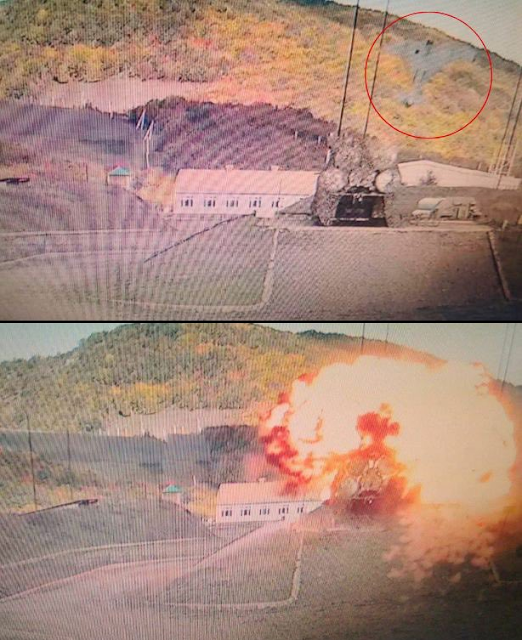
(part 2 to be continued)


